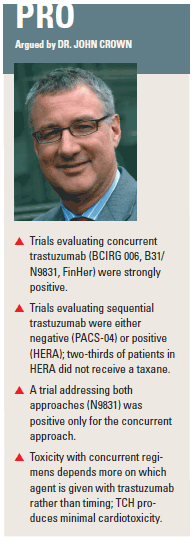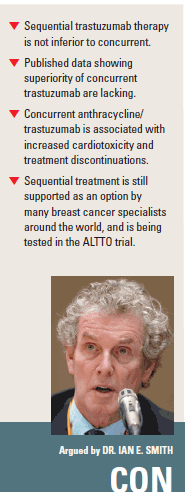Trastuzumab in the adjuvant setting: Is concurrent treatment better than sequential?
STOCKHOLM-Published data overwhelmingly support the use of trastuzumab (Herceptin) concurrently with chemotherapy, according to John Crown, MD, a consultant oncologist at St. Vincent’s Hospital in Dublin, Ireland. On the other hand, there is no evidence that sequential delivery is less effective than concurrent therapy, and it is definitely less toxic, commented Ian E. Smith, MD, head of the Breast Unit at Royal Marsden Hospital in London.
ABSTRACT: The question remains open, since the final analysis of the only head to head concurrent vs sequential trial has not yet been reported.
STOCKHOLM-Published data overwhelmingly support the use of trastuzumab (Herceptin) concurrently with chemotherapy, according to John Crown, MD, a consultant oncologist at St. Vincent’s Hospital in Dublin, Ireland. On the other hand, there is no evidence that sequential delivery is less effective than concurrent therapy, and it is definitely less toxic, commented Ian E. Smith, MD, head of the Breast Unit at Royal Marsden Hospital in London.
At ESMO 2008, Drs. Crown and Smith debated whether a concurrent or sequential regimen is the optimal delivery strategy for trastuzumab in HER2- positive breast cancer patients.
Evidence for concurrent therapy
The evidence for concurrent therapy comes from three major trials: NSABPB31 and the Intergroup NCCTG N9831 (joint analysis), the BCIRG 006 trial, and the FinHer trial, Dr. Crown said.
The joint analysis of the two U.S.-based trials, which evaluated doxorubicin/ cyclophosphamide followed by paclitaxel (AC→T) with or without trastuzumab, showed a staggering improvement in disease-free survival (DFS) at four years, with a highly significant hazard ratio (HR) of 0.48 with the addition of trastuzumab.

Similarly, in BCIRG 006, recurrences were significantly reduced with concurrent therapy. BCIRG 006 evaluated AC→T (docetaxel), AC→TH (trastuzumab), and a nonanthracycline regimen of docetaxel (Taxotere), carboplatin, and trastuzumab (TCH), based on laboratory findings of synergy among these agents.
AC→TH and TCH were both significantly better than the nontrastuzumab AC→T arm, reducing recurrences by 39% and 33%, and risk of death by 41% and 34%, respectively. TCH was associated with significantly less cardiotoxicity and may, therefore, be preferable, Dr. Crown said.
Finally, FinHer compared docetaxel followed by fluorouracil, epirubicin, and cyclophosphamide (FEC) with vinorelbine followed by FEC, with or without a short course of trastuzumab (nine weekly cycles).
“Longer follow-up should tell us whether a briefer, less expensive trastuzumab regimen can be substituted for longer schedules,” Dr. Crown said.
The HERA study was positive for sequential trastuzumab, with HRs of 0.64 for DFS and 0.66 for OS, but HERA has problems, according to Dr. Crown.
HERA randomized patients to trastuzumab or observation after treatment with any chemotherapy regimen, which for 68% of patients lacked a taxane and for 6% lacked an anthracycline. Many, therefore, received obsolete chemotherapy that failed to take advantage of the possible synergy between taxanes and trastuzumab, he said.
The only truly negative trastuzumab study to date was the PACS-04 trial, which compared a regimen with docetaxel (E75, D75) to one without (FE100C), followed by one year of trastuzumab or observation. Th e outcome was sobering: Four-year DFS was similar between the arms (73%). “While I favor concurrent therapy, I would have predicted that sequential trastuzumab would be better than no trastuzumab,” he said.
The only attempt to compare combination and sequential trastuzumab was part of the N9831 design. The trial compared AC→T (paclitaxel), AC→T→ H (trastuzumab) and AC→T + H→H, and found that AC→T + H→H reduced risk by 51% over AC→T, while the AC→T→H (sequential) delivery reduced risk modestly, by 13%.
More telling was the comparison between concurrent and sequential delivery of trastuzumab, showing a 36% greater reduction in risk with AC→T + H→H than with AC→T→H. Overall survival results followed the same pattern. “It is imperative that the data comparing the combination to the sequential approach be published or presented,” Dr. Crown said.
While toxicity is indeed a concern with combinations, it is more a matter of which agent is given with trastuzumab rather than the timing of treatment, he said. The lowest cardiotoxicity in these studies was with TCH in BCIRG 006. “The question is whether we can now eliminate the anthracycline in some cases,” Dr. Crown said.

Taking these data forward, he said, “we should follow an intellectual approach that considers synergy and involves pilot evaluations of candidate combinations.” He noted that while concurrent treatment has been developed in this rational manner, “sequential therapy has been more a matter of ‘Let’s give it and see what happens’. Sequential treatment has not been a strategy, but a compromise among trialists who cannot agree on protocols. In the molecular era, we must do things differently. Studying regimens by adding a new drug to an old regimen will no longer be acceptable.”
Sequential therapy: An evidence-based option
Dr. Smith argued that concurrent treatment is not better than sequential treatment. “I do not say that sequential is more effective, nor even that sequential is as effective, but there is no evidence that sequential delivery is less effective,” he said. “Since sequential treatment is also less cardiotoxic, it is still reasonable to give trastuzumab sequentially or concurrently.”
Dr. Smith described the HERA trial as “prophetic,” finding a benefit for the sequential delivery of trastuzumab.
“Outside of clinical trials, different centers in different countries require different protocols. Patients in HERA did not receive ‘random’ chemotherapy but chemotherapy based on committee decisions and published evidence-based data,” he said.
The chemotherapy that Dr. Crown calls “obsolete” is still being used at the Royal Marsden, Memorial Sloan-Kettering, and across the world, Dr. Smith pointed out. Furthermore, the value of taxanes is still unclear. The largest taxane trial ever conducted-UK Taxotere as Adjuvant Chemotherapy (TACT)-recently found no benefit for the taxane, he said, adding that these data will soon be published.
“As for N9831, in which the concurrent arm produced better DFS than the sequential arm, note that these data have not been published because the final analysis requires 590 events, while just 137 events have occurred,” he said. “Perhaps the final analysis will not show such a spectacular benefit as the original.”
Comparison across trials
Dr. Smith pointed out interesting observations when data from different trials are compared. “The BCIRG 006 design was practically identical to the joint analysis of B-31 and N9831, yet its outcomes were the same as those seen with sequential treatment in HERA,” he said. Hazard ratios were 0.48 in the joint analysis, and 0.61 and 0.64 with BCIRG and HERA, respectively; absolute DFS gains were 12.8%, 6.0%, and 6.3% in the three trials. The TCH arm of BCIRG 006 also had the same DFS, with HR of 0.67 and 5% absolute gain.
“We must beware the trap of making inter-trial comparisons, as the results depend on which trials you pick to compare,” he said.
Dr. Smith also discussed the possible disadvantages of concurrent therapy. Cardiac toxicity clearly increases with anthracyclines plus trastuzumab, based on findings from N9831, B-31, and BCIRG 006, he said, and treatment discontinuations more than triple, compared with sequential treatment.
Eliminating anthracyclines?
As to the question of whether anthracyclines can be eliminated in patients receiving trastuzumab, he said the answer is not yet clear. (See “Move to abandon anthracyclines in adjuvant breast cancer is premature,” November 2008, page 2). In the second analysis of BCIRG 006, TCH was almost as effective as AC→TH, with DFS of 82% and 83%, respectively, but in the first interim analysis, TCH looked more like the control arm, Dr. Smith said.
“We need to see the data in print before we change global practice,” he said. “While major trials in many thousands of patients confirm the activity of anthracyclines in HER2-positive breast cancer, arguments for TCH are based on just 1,000 patients, one positive interim analysis, one negative interim analysis, and no formal published data.
“I believe it is appropriate to consider TCH only for higher-risk patients,” Dr. Smith added.
ALTTO trial
Finally, Dr. Smith pointed out that many of the world’s experts believe in sequential treatment, which is being tested in the important ALTTO trial.
The trial compares the use of trastuzumab and lapatinib (Tykerb), given alone, concurrently, or sequentially, after anthracycline-based chemotherapy.
“Accrual to ALTTO is proceeding rapidly, mainly in the sequential trastuzumab/lapatinib arm,” he said. “Obviously, many oncologists are unconvinced that sequential treatment is inferior.”
Sequential treatment remains an evidence-based option, Dr. Smith concluded. “That said, I acknowledge that as time evolves, concurrent delivery may prove more efficacious, though at present we should base treatment decisions on published, peer-reviewed evidence,” he stated.
How Supportive Care Methods Can Improve Oncology Outcomes
Experts discussed supportive care and why it should be integrated into standard oncology care.